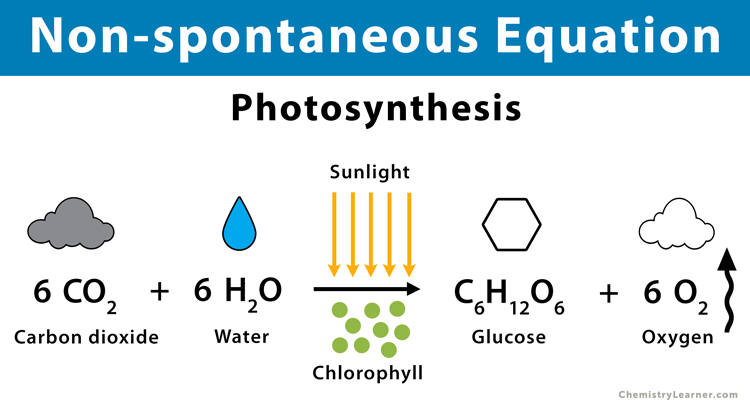Non Spontaneous Reaction Example is one where product generation is not promoted under the given conditions. A reaction must be endothermic and accompanied by a drop in entropy to be non-spontaneous.
Let’s have a look at the examples below-
Melting of ice non spontaneous reaction examples
Melting of ice is a non-spontaneous process because in ice the molecules are very well packed, the main reason for this is the presence of H – a bond, and therefore ice has low entropy. As the ice melts the intermolecular force is broken and also the order is interrupted so there will be a sudden change in the entropy. The main condition of a non-spontaneous reaction is that there will be a sudden change in the entropy thus the reaction said that is non-spontaneous.
2H2O → 2H2 + O2
Water Hydrogen + oxygen
Reaction of photosynthesis
Because photosynthesis is made up of a sequence of non-spontaneous chemical processes, it is a non-equilibrium system. The total process is endothermic (H > 0), with a decrease in the system’s entropy (S < 0) and a positive Gibbs free energy (G > 0).
Because energy from the sun or sunlight is absorbed during the process of photosynthesis, it is termed an endothermic reaction.
6CO2 + 6H2O → C2H12O6 + 6O2
Carbon dioxide + water (Chlorophyll) Glucose Oxygen

Combustion of methane
Exothermic burning of organic molecules such as methane is a non-spontaneous process. A flame or spark is required to start the process. Because of this reason, the combustion of methane is a non-spontaneous reaction.
CH4 + H2O → CO2 + 2H2O
Methane + Water gives Carbon dioxide + Water
Our atmosphere consists of a mixture of nitrogen and gaseous oxygen and this response to forms nitrous oxide. This reaction is non-spontaneous at normal temperature and pressure, it is highly endothermic, and a slightly positive change takes place.
- Formation of Nitrogen monoxide
- Our atmosphere consists of a mixture of nitrogen and gaseous oxygen and this response to forms nitrous oxide. This reaction is non spontaneous at normal temperature and pressure, it is highly endothermic and slightly positive change take place.
N2 + O2 → 2NO
Nitrogen Oxygen Nitrogen monoxide
Water Electrolysis:
The electricity withinside the shape of energy is provided with water (H2O), which decomposes into hydrogen (H2) and oxygen (O2). This system is called electrolysis and is a redox reaction
2 H2O (l) → 2 H2 (g) + O2 (g)
Ozone formation:
Conversion of oxygen (O2) to ozone (O3) is a non-spontaneous method in any respect to temperatures. It is pushed via way of means of ultraviolet (hν) mild from the sun.
3 O2 (g) + hν → 2 O3 (g)
Reaction of the Electrolytic cell
Whilst electrolytic cells contain non-spontaneous reactions and accordingly require an outside electron supply like a DC battery or an AC energy supply. Since electrons float from it, the anode in an electrolytic molecular is positive, whilst the cathode is terrible while electrons circulate it. In an electrolytic molecular, an outside voltage is carried out to pressure a nonspontaneous reaction.
Read more about on Properties of Peptide bond: Detailed Fact and Comparative Analysis
How we can understand whether a reaction is non – spontaneous or not?
If Gibbs’ free energy is negative, then the reaction is spontaneous, and if it’s positive, then it’s non-instantaneous.
Significance of non-spontaneous reaction
A spontaneous technique is one that happens certainly beneathneath positive conditions. A nonspontaneous technique, on the alternative hand, will now no longer take vicinity until it is “driven” with the aid of using the chronic entry of electricity from an outside source.
If H and S are both negative, the reaction is only spontaneous at low temperatures. Because the entropy term is a lower positive quantity at low temperatures, the negative enthalpy is more likely to drive the reaction’s spontaneity.
Hi….I am Niviya Rajan, I have completed my Master’s in Chemistry. I always like to explore new areas in the field of Chemistry. Apart from this, I like to read and travel.

Hi Fellow Reader,
We're a small team at Techiescience, working hard among the big players. If you like what you see, please share our content on social media. Your support makes a big difference. Thank you!